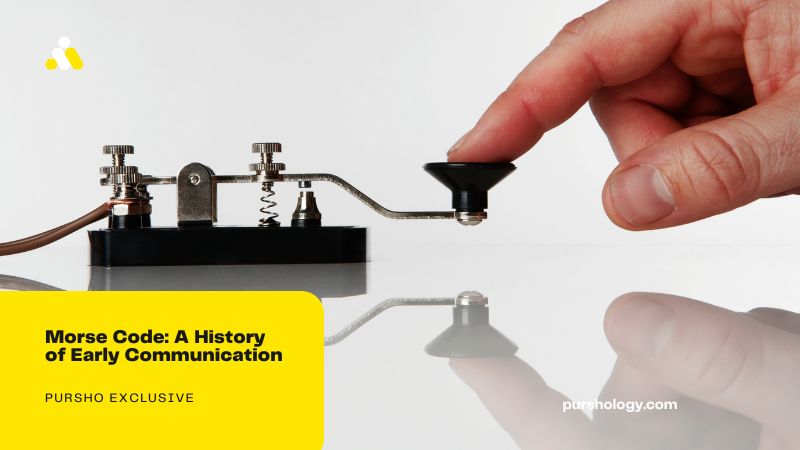Before the idea of the cellphone, people had been attempting to communicate across large distances for a very long period of time. If you were an amateur radio operator in the 1850s or now, that is a form of Morse code. Maintaining international order in the past required this kind of communication.
The semaphore telegraphs that were in use at the time were comparable to Morse’s initial encryption technique. It required entering three- or four-digit numbers into a codebook and assigning those numbers to the appropriate words.
The transmitting operator formed these numerical groupings from words. The receiving operator converted them back into words using this codebook. Morse made some effort to design this code vocabulary. This article explores the intriguing past of the Morse Code and its distinct position in communication history.
What is Morse code?
Morse Code is a communication system that sequences characters over two different signal intervals using dots and dashes. Electrical pulses of various lengths are used to transmit these codes. Alfred Vail and Samuel Morse were the creators of the Morse code.
Dashes and dots make up the alphabet used in Morse code. To utilize it, you must tap the appropriate number of dashes and dots and pause for the appropriate length of time. There are more spaces in between words than there are letters in a word. The length of the pauses and the number of dots and dashes used indicate what words or numbers the person using Morse Code is trying to convey.
The Functions of Morse Code in Communication
The alphabet’s letters, numerals, and punctuation are all represented in Morse Code by a succession of dots and dashes. Longer signals are represented by dashes and shorter ones by dots. This binary system is flexible and adaptable since it can encode complicated messages with a small number of symbols.
The Morse Code’s introduction to telegraphy transformed long-distance communication. The speed and effectiveness of information sharing significantly increased with the quick transmission of messages across electrical lines. The emergence of telegraph networks reinforced the significance of the Morse Code in establishing connections between faraway areas.
The History and Importance of Morse Code in Early Communication
Morse code is closely linked to the development of communication. It is a method of encoding written characters with a series of dots and dashes. From Samuel Morse’s invention in the 1830s until its broad application in telegraphy, the Morse Code significantly influenced how people communicate.
Samuel Morse’s motivation was to develop a quicker and more efficient communication method. Born in 1791, Morse transitioned from the arts to technology, working with expert mechanic Alfred Vail to create the Morse Code. Their collaboration produced a breakthrough in communication that would alter the path of history.
The debate has been significantly impacted by the use of a Morse code translator. It is a tempting option in a variety of situations due to its many benefits. Morse code allows for more accurate and speedy communication. Users can send data quickly and precisely.
Morse Code continues to thrive with the help of a Morse Code translator. This tool preserves Morse code knowledge and makes it accessible to a broader audience.
With user-friendly interfaces, these translators have breathed new life into this timeless communication method. The accessibility provided by Morse Code translator tools ensures that this rich tradition continues to captivate new generations.
Applications of Morse Code in Communication
With its dots and dashes, Morse Code is more than just a device from the past. It’s a flexible language with uses in many different communication domains.
Military Communication
The Morse Code is a silent hero in the annals of military history. It was a vital instrument during times of conflict because of its capacity to transmit communications effectively and with little chance of interception. The Morse Code was essential for transmitting confidential information during World War II.
Soldiers may use flashlights to transmit communications, thanks to the Morse Code. This encrypted, noiseless method of communication offered a tactical edge. The Morse Code is still used in military training, even in this day and age. The Morse Code is taught to soldiers as an additional ability.
Amateur Radio
Inside amateur radio or ham radio, there is a devoted following of Morse Code users. On this subject, enthusiasts frequently prefer to communicate via Morse code.
Although Morse Code is effective for long-distance communication, it continues to be used in amateur radio. When verbal transmissions are prone to distortion or weakness, Morse Code offers a dependable substitute. With basic equipment, ham radio operators may send messages in Morse code.
Moreover, knowing Morse Code is a common skill test in the amateur radio world. This preserves the Morse Code and pays tribute to its historical value.
Maritime Communication
For many years, the wide ocean has been filled with the steady pulse of the Morse Code. The Morse Code played a major role in maritime communication between ships and land.
The SOS distress signal, which consists of three short dots, three long dashes, and three small dots once more (…—…), is the most famous application of Morse Code in maritime communication. Numerous lives have been saved by this widely accepted cry for assistance.
The Morse Code is still required for marine education. Basic Morse Code knowledge is frequently taught to sailors and other marine workers as part of their schooling.
Communication in an Emergency
Morse code is a useful communication tool in emergencies. To broadcast such messages, ham radio transmitters need less power and bandwidth than other conventional voice communication tools. These messages are intended just for individuals who are proficient programmers. It’s a practical tool for personal communication.
Final Thoughts
The development of the Morse Code from Samuel Morse’s creative imagination to its crucial function in international communication is a fascinating historical narrative. The persistent value of the Morse Code is attested to by the continual efforts to resurrect it and by its cultural impact. Applications for Morse Code demonstrate its continued importance in a variety of industries. Morse code is still widely used as a dependable and efficient message-transmission method. This language of dashes and dots is still relevant today.
Author Bio
 Author Name: Umar Rashid
Author Name: Umar Rashid
Author Email: ur30501@gmail.com
Author Bio:I am a content writer and researcher with a passion for technology and artificial intelligence. He has been writing for over 2 years and has published articles on a variety of topics, including AI, machine learning, and natural language processing, Business, Education, Finance. He has written interesting stuff for different platforms and he keeps amazing people with his writing talent.







